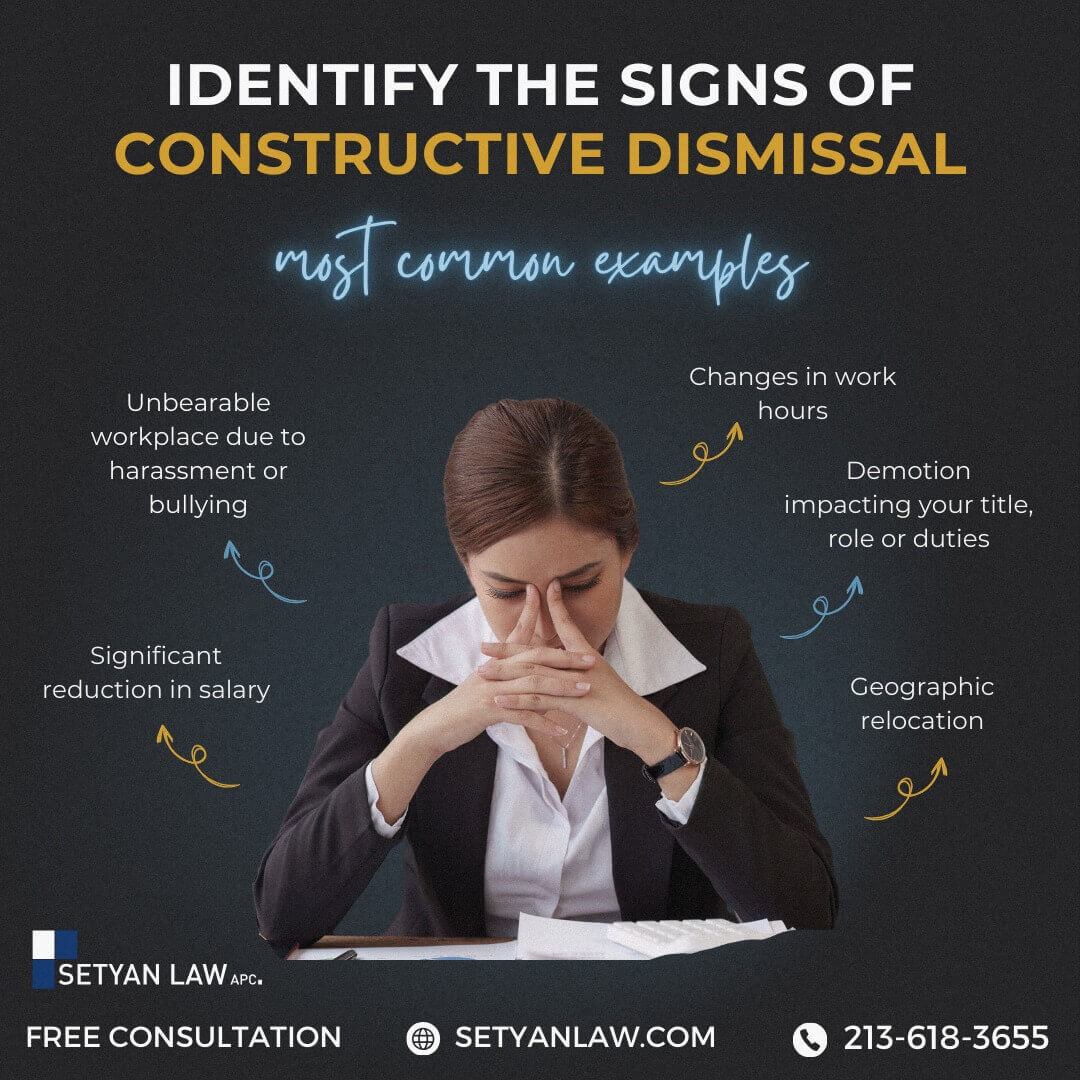Updated September 20, 2025
Constructive Dismissal
Constructive dismissal is a complex legal concept that arises when an employee resigns due to their employer’s behavior, which effectively forces them to leave their position. Unlike traditional dismissal, where an employer directly terminates an employee, constructive dismissal occurs when an employee feels they have no choice but to resign due to a significant breach of their employment contract. This article will delve deep into the nuances of constructive dismissal, providing examples, exploring legal implications, and offering guidance for employees who may find themselves in such situations.
Defining Constructive Dismissal
Constructive dismissal refers to a situation where an employee resigns as a direct result of their employer’s actions or failures. This can include a wide range of behaviors, from changes in working conditions to harassment or discrimination.
The key element is that the employer’s conduct must be so severe that it effectively nullifies the employment contract, compelling the employee to resign.
Legal Framework
In California, constructive dismissal—also known as constructive discharge—occurs when an employer deliberately creates or knowingly permits intolerable working conditions that compel an employee to resign. In such cases, the resignation is treated as a termination, potentially giving rise to a wrongful termination claim.
Importance of Evidence
For a constructive dismissal claim to be successful, the employee must gather substantial evidence to support their case. This can include emails, witness statements, and records of grievances raised with the employer. The burden of proof lies with the employee, making it essential to document all relevant interactions and incidents.
Common Types of Constructive Dismissal
Understanding the various scenarios that can lead to constructive dismissal can help employees recognize when their rights may be compromised. Here are some common examples:
1. Significant Changes to Employment Terms
Employers may sometimes alter the terms of employment without the employee’s consent. This can involve:
- Changing Work Hours: Forcing an employee to work longer hours without prior agreement can be deemed a breach of contract.
- Relocation: Mandating an employee to move to a different location that is significantly less convenient can also constitute constructive dismissal.
2. Harassment and Bullying
A toxic work environment can lead to constructive dismissal claims. If an employee faces ongoing harassment or bullying and the employer fails to address these issues, the employee may feel compelled to resign. Examples include:
- Verbal Abuse: Continuous derogatory comments from supervisors or colleagues.
- Isolation: Deliberately excluding an employee from team activities or communications.
3. Unfair Treatment
Discrimination based on protected characteristics can also lead to constructive dismissal. If an employee is subjected to unfair treatment compared to their colleagues, it may justify a resignation. Examples include:
- Discrimination: Treating an employee less favorably due to their gender, race, or disability.
- Retaliation: Punishing an employee for exercising their rights, such as filing a grievance.
4. Failure to Provide a Safe Working Environment
Employers have a legal obligation to ensure a safe working environment. If an employee is forced to work under unsafe conditions and the employer fails to address these concerns, it can lead to a constructive dismissal claim. Examples include:
- Ignoring Health and Safety Regulations: Not addressing known hazards that could harm employees.
- Failure to Provide Necessary Equipment: Not supplying adequate tools or safety gear for the job.
5. Non-Payment or Reduction of Salary
One of the most straightforward breaches of contract occurs when an employer fails to pay an employee their agreed-upon salary. This can include:
- Withholding Pay: Not paying wages on time or at all.
- Unjustified Pay Cuts: Reducing an employee’s salary without a valid reason or prior agreement.
3 Examples of Constructive Dismissal
1: Demotion Without Cause
Employee:
Sarah Johnson of Midtown Marketing Co.
Scenario:
Sarah was a senior project manager at Midtown Marketing Co. for 7 years with an excellent performance record. One day, without warning or explanation, she was reassigned to an entry-level role with significantly reduced responsibilities and no team to manage. Her salary remained the same, but the demotion damaged her professional reputation and future prospects.
Constructive Dismissal:
Sarah resigned and claimed constructive dismissal, arguing that the demotion was a fundamental change to her employment contract made without her consent.
2: Hostile Work Environment
Employee:
Daniel Lee of Apex Tech Solutions
Scenario:
Daniel worked as a software developer at Apex Tech Solutions. After raising concerns about unethical practices in the company, his manager began excluding him from team meetings, assigning him unrealistic deadlines, and making sarcastic remarks about his “whistleblowing.” The toxic environment made it impossible for Daniel to perform his duties.
Constructive Dismissal:
Daniel quit his job and filed a claim for constructive dismissal, arguing that the hostile environment created by management forced him to resign.
3: Unilateral Pay Cut
Employee:
Maria Torres of GreenWave Architects
Scenario:
Maria, an architectural designer, was informed by GreenWave Architects that her salary would be reduced by 30% due to “budgetary reasons,” without any negotiation or prior agreement. The company did not apply the pay cut to other employees in similar roles.
Constructive Dismissal:
Maria resigned, claiming constructive dismissal because the significant pay cut was a unilateral and fundamental change to her employment terms.
The Process of Claiming Constructive Dismissal
If an employee believes they have been constructively dismissed, they should follow a structured approach to address the situation:
Step 1: Document Everything
As mentioned earlier, documentation is crucial. Employees should keep detailed records of incidents, communications, and any grievances raised. This evidence will be vital in supporting their claim.
Step 2: Raise a Formal Grievance
Before resigning, employees should consider raising a formal grievance with their employer. This allows the employer an opportunity to address the issues and may prevent the need for resignation.
Step 3: Seek Legal Advice
Consulting with an employment lawyer can provide valuable insights into the viability of a constructive dismissal claim. Legal professionals can help navigate the complexities of employment law and ensure that the employee’s rights are protected.
Step 4: Resignation
If the situation does not improve and the employee feels they have no choice but to resign, they should do so in writing. The resignation letter should clearly state the reasons for leaving and reference the breaches of contract.
Step 5: File a Claim
After resignation, employees can file a claim with an employment tribunal. This should be done promptly, as there are strict time limits for bringing a claim.
Legal Implications of Constructive Dismissal
Constructive dismissal claims can have significant legal implications for both employees and employers.
Employee Rights
Employees who successfully prove constructive dismissal may be entitled to various remedies, including:
- Compensation: This can include loss of earnings, benefits, and any other financial losses incurred due to the dismissal.
- Reinstatement: In some cases, employees may seek to be reinstated to their former position.
Employer Liabilities
For employers, defending against a constructive dismissal claim can be costly and time-consuming. If found liable, they may face:
- Financial Penalties: Compensation payments can be substantial, depending on the circumstances of the case.
- Reputational Damage: Negative publicity can harm an employer’s reputation, making it difficult to attract and retain talent.
Preventing Constructive Dismissal Claims
Employers can take proactive steps to mitigate the risk of constructive dismissal claims. Here are some strategies:
1. Clear Communication
Maintaining open lines of communication with employees can help address concerns before they escalate. Regular check-ins and feedback sessions can foster a positive work environment.
2. Fair Treatment
Ensuring that all employees are treated fairly and equitably can prevent feelings of discrimination or favoritism. Implementing clear policies regarding workplace behavior and expectations can help.
3. Addressing Grievances Promptly
Employers should take all grievances seriously and address them promptly. This demonstrates a commitment to employee welfare and can prevent potential claims.
4. Training and Development
Providing training for managers and supervisors on how to handle employee issues can create a more supportive workplace culture. This includes training on harassment prevention and conflict resolution.
Conclusion
Understanding constructive dismissal is essential for both employees and employers. Employees should be aware of their rights and the circumstances that may lead to a claim, while employers must recognize the importance of fostering a positive work environment. By taking proactive measures to address potential issues, employers can minimize the risk of claims and ensure a fair and respectful workplace for all.
If you believe you have been constructively dismissed, it is crucial to seek legal advice to understand your rights and options. Remember, you do not have to navigate this challenging situation alone; support is available to help you through the process.
If you’re employed by a California employer, contact an expert wrongful termination attorney first, for expert assistance regarding your case. Call today for a free and confidential consultation.







